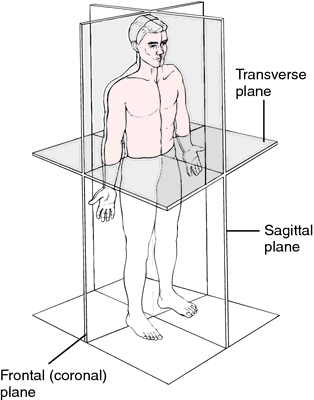What is the technical term for up & down, back & forth, and left & right?
Solution 1:
Consider using Transversal or Sagittal. As you pointed out it is hard to describe such a concept because the position you want to describe is extra-relatal from the observer unlike common directional words we use. North and South are close but they are not usually imagined from the first person point of view are are un-conviently pointed to a fixed spot on the horizon in this case. Since you mentioned a third term to coalesce with horizontal and vertical the answer will be a bit subjective because the way the distances and movement between points can be described are similar in both the sagittal and transverse planes. What you are describing is comparing two points along the intersection of the horizontal and vertical planes or more likely between the sagittal and transverse planes.

In this case consider using Transversal. The intersection of the vertical plane with the horizontal plane would form a transverse. This medical definition from thefreedictionary.com describes:
transverse plane of space, n an imaginary plane that cuts the body in two, separating the superior half from the inferior half, and that lies at a right angle from the body's vertical axis.
And the definition for sagital:
sagittal plane
n.
A longitudinal plane that divides the body of a bilaterally symmetrical animal into right and left sections.
Since forward and backward movement at the intersection of the vertical planes is what you are describing, transverse or transversal may be a better choice, however when we describe vertical it is ambiguous whether we are describing a sagittal plane or a coronal
Because of this it is still necessary to describe the relative position between the points. You can use biological or aeronautical terms to describe forward and backward through the transverse plane: dorsal/posterior or aft for back and ventral/anterior and fore for forward.
Edit
After reading some of the other answers it seems clear to me that you are stuck with either a frame of reference to the earth or from the point of view of self. Perhaps the answer here is to abandon the term vertical and horizontal and use for coronal, sagittal, and transversal although that still does not solve your earth point of view in which case you can use latitude, longitude, and altitude.
But keep in mind it's all relative. Pick a system and stay consistent.
Solution 2:
There are standards for this, precisely because it is a basically arbitrary decision, and it's very hard to compare published works if everyone uses their own system. You want the body fixed coordinate system for the ear's perspective of the world, and the NED earth coordinate system for the fixed reference frame. Be glad you aren't trying to land a probe on an asteroid via multiple slingshot maneuvers. Those poor sods have dozens of coordinate systems to keep track of. Body doesn't mean human body, it means anything like an airplane free to move about.
https://pixhawk.org/dev/know-how/frames_of_reference
Solution 3:
In airplanes, it is yaw, pitch and roll describing motion around each axis. Not a pilot myself, but I believe it is positive/negative degrees from the neutral standard.
From Wikepedia: An aircraft in flight is free to rotate in three dimensions: pitch, nose up or down about an axis running from wing to wing; yaw, nose left or right about an axis running up and down; and roll, rotation about an axis running from nose to tail. Aircraft principal axes - Wikipedia